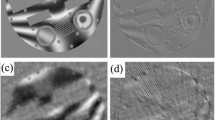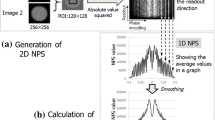Abstract
The singularity function analysis (SFA) model is a mathematical tool that allows representing an image with much less coefficients than the conventional Fourier transform (FT) model while maintaining a better image quality. The performance of the SFA method for reconstructing medical images may however degrade if unwanted phase drifts are present in the acquired image. This paper proposes a new SFA-based reconstruction scheme by taking into account phase drifts. To this end, phase drifts are first mathematically formulated and corrected. The singularity function model is then applied to represent the phase-corrected image. The performance of this phase-corrected SFA reconstruction scheme is evaluated using both simulated and real brain images, and compared with the conventional FT model and SFA method without phase correction. The results demonstrate that the proposed reconstruction method achieves significant improvement in image quality.






Similar content being viewed by others

References
Hasse, A., et al. (1986). FLASH imaging, rapid NMR imaging using low flip-angle pulse. Journal of Magnetic Resonance, 67, 258–266.
Henning, J., Naureth, A., & Friedburg, H. (1986). RARE Imaging: A fast imaging method for clinical MR. Magnetic Resonance in Medicine, 3, 823–833.
Margosian, P., Schmitt, F., & Purdy, D. (1986). Faster MR imaging: Imaging with half the data. Health Care Instrumentation, 1, 195–197.
van Cuppen, J., & van Est, A. (1987). Reducing MR imaging time by one-sided reconstruction. Magnetic Resonance Imaging, 5, 526–527.
Haacke, E. M., Lindskog, E. D., & Lin, W. (1991). A fast, iterative partial Fourier technique capable of local phase recovery. Journal of Magnetic Resonance, 92, 126–145.
Noll, D. C., Nishimura, D. G., & Macovski, A. (1991). Homodyne detection in magnetic resonance imaging. IEEE Transactions on Medical Imaging, 10, 154–163.
McGibney, G., Smith, M. R., Nicholas, S. T., & Crawley, A. (1993). Quantitative evaluation of several partial-Fourier reconstruction algorithms used in MRI. Magnetic Resonance Imaging, 30, 51–59.
Yuan, L., Ying, L., Xu, D., & Liang, Z. P. (2006). Truncation effects in SENSE reconstruction. Magnetic Resonance Imaging, 24, 1311–1318.
Peng, H. D., Sabati, M., Lauzon, L., & Frayne, R. (2006). MR image reconstruction of sparsely sampled 3D k-space data by projection-onto-convex sets. Magnetic Resonance Imaging, 24, 761–773.
Hu, Y., & Glover, G. H. (2006). Partial-k-space acquisition method for improved SNR efficiency and temporal resolution in 3D fMRI. Magnetic Resonance Medicine, 55, 1106–1113.
Lustig, M., Donoho, D., & Pauly, J. M. (2007). Sparse MRI: The application of compressed sensing for rapid MR imaging. Magnetic Resonance Medicine, 58, 1182–1195.
Njiwa, J. Y., Zhu, Y. M., Robini, M. C., & Magnin, I. (2007). Magnetic resonance image reconstruction using analytic image representation. Nuclear Instruments and Methods in Physics Research A, 571, 73–76.
Peng, H. D., Draper, J. N., & Frayne, R. (2008). Rapid passive MR catheter visualization for endovascular therapy using nonsymmetric truncated k-space sampling strategies. Magnetic Resonance Imaging, 26, 293–303.
Luo Jianhua, J. H., & Zhu, Y. M. (2004). MR image reconstruction from truncated k-space using a layer singular point extraction technique. IEEE Transactions on Nuclear Science, 51, 157–169.
Bracewell, R. N. (1978). The Fourier transform and its application (2nd ed.). New York: McGraw-Hill.
Cocosco, C., Kollokian, V., Kwan, R.- S., & Evans, A. (1997). Brainweb: Online interface to a 3d MRI simulated brain database. NeuroImage, 5, S425.
Collins, D. L., Zijdenbos, A. P., Kollokian, V., Sled, J. G., Kabani, N. J., Holmes, C. J., et al. (1998). Design and construction of a realistic digital brain phantom. IEEE Transactions on Medical Imaging, 17, 463–468.
Acknowledgment
This work was partly supported by the NSF of China under 30670574, the project Mira Recherche 2005 of the Region Rhône-Alpes of France, the project Arcus Chine 2005 of French Ministry of Foreign Affairs, Shanghai International Cooperation Grant under 06SR07109, and High Technology Research Development Plan (863 plan) of P. R. China under 2006AA020805.
Author information
Authors and Affiliations
Corresponding author
Rights and permissions
About this article
Cite this article
Luo, J.H., Luo, H. & Zhu, Y.M. Image Reconstruction Scheme Based on Phase Correction and Singularity Function Analysis Model. J Sign Process Syst Sign Image Video Technol 54, 79–88 (2009). https://doi.org/10.1007/s11265-008-0190-x
Received:
Revised:
Accepted:
Published:
Issue Date:
DOI: https://doi.org/10.1007/s11265-008-0190-x



